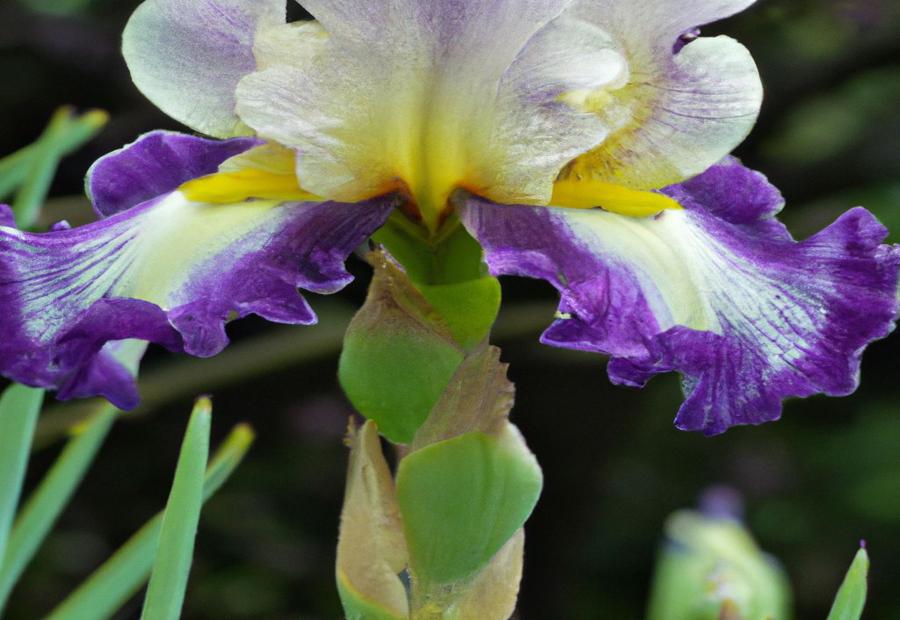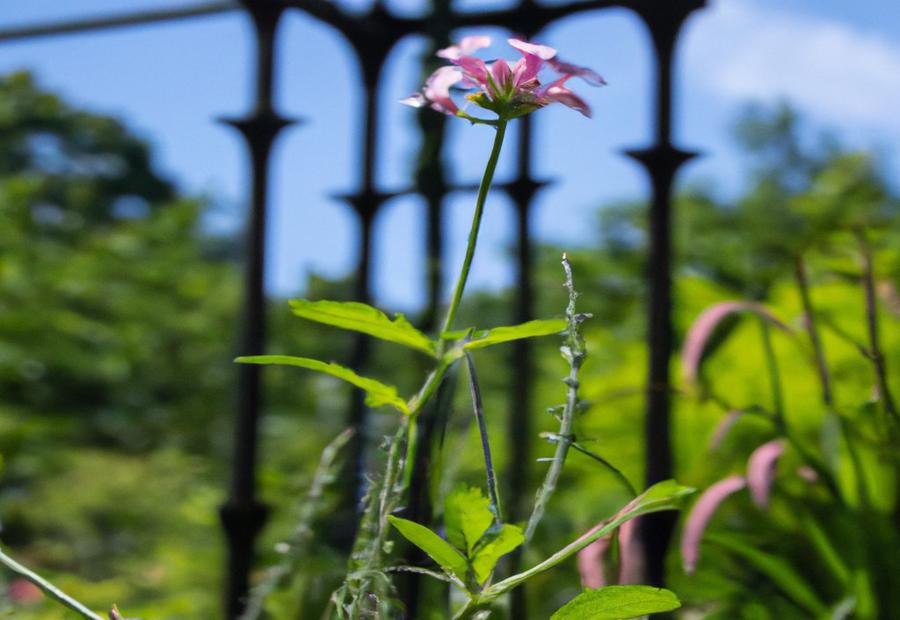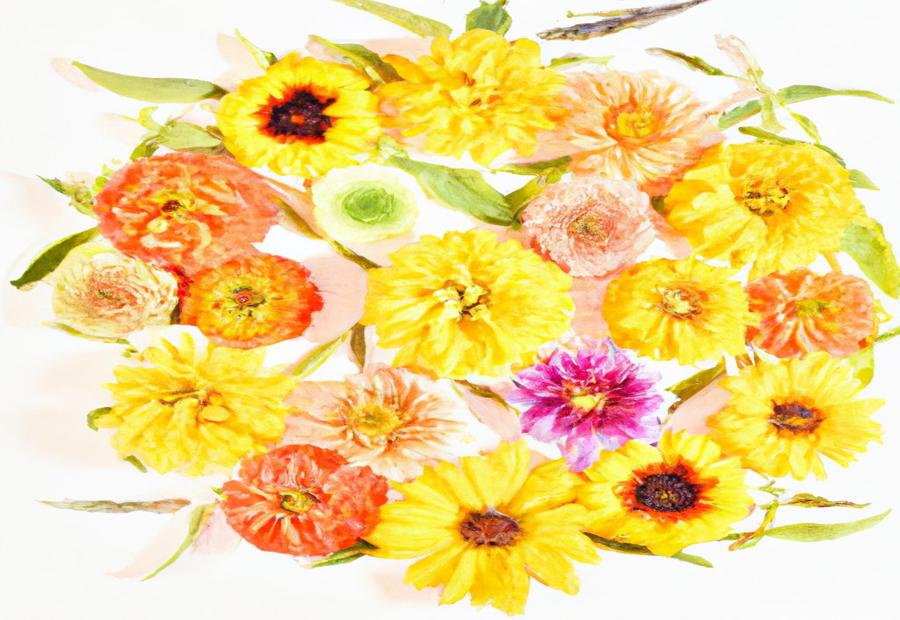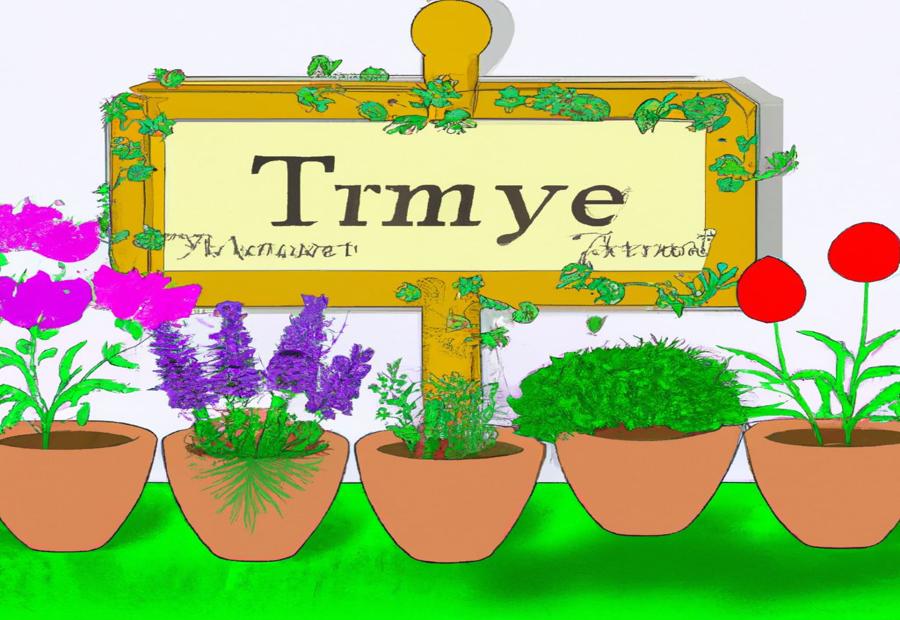Key Takeaway:
- Flowers that start with T offer a diverse range of beauty and characteristics, making them an attractive addition to any garden or landscape.
- Some notable T flowers include the Thimbleweed, Tall Bearded Iris, Tall Verbena, Tiger Lily, Toad Lily, and Treasure Flower, each with their own unique traits and growing requirements.
- These flowers provide a wide array of colors, blooming seasons, and symbolism, allowing for creative and visually appealing garden designs.
Introduction: The Beauty of Flowers That Start With T

Photo Credits: Gardeninggurus.Org by Sean Johnson
The letter “T” brings to mind stunning flowers that exude captivating beauty. Tulips, renowned for their vibrant colors and graceful shapes, bring a unique charm. Tiger lilies, with their distinct spots and curved petals, are an exquisite option. Trilliums, with their delicate blooms and enticing fragrance, also hold a special place. Thistle is a captivating flower that boasts prickly leaves and a vibrant purple or pink blossom. The trumpet vine cascades with fiery orange or red flowers that attract hummingbirds. Tropical orchids thrive in diverse climates, showcasing a dizzying array of patterns, shapes, and colors.
Tulips symbolize elegance and grace and come in a wide variety of colors. Trout lilies have unique spotted leaves and delicate yellow blooms. Thunbergia, an enchanting vine, produces trumpet-shaped flowers in shades of yellow, orange, or purple, attracting butterflies and hummingbirds. All these flowers bring a touch of splendor to any environment.
Thimbleweed
Thimbleweed, a fascinating flower that begins with the letter T, has unique characteristics and a captivating habitat. Discover its description, learn about the growing conditions it thrives in, and be aware of its toxicity and necessary precautions. This floral wonder promises to intrigue and inform those with an interest in the natural world.
Description and Characteristics
Thimbleweed is a flower that starts with the letter T. It’s known for its distinctive description and characteristics. A perennial herbaceous plant of the Ranunculaceae family, Thimbleweed has a unique appearance. Small white or yellowish flowers are surrounded by greenish-yellow bracts. The flowers have numerous petals and are clustered in a thimble-like shape, hence its name. Plus, there’s feathery seed heads that look like thimbles – adding to its visual appeal.
Habitat and growing conditions? Thimbleweed is typically found in woodlands, meadows, and prairies. It likes moist soil and partial shade, but can adapt to different environments. It’s native to North America and can be found in various regions across the continent.
Though not toxic to humans or animals, beware! Thimbleweed contains alkaloids that may irritate skin or cause allergies. So, handle with caution and wear protective gloves when necessary.
In conclusion: Thimbleweed is a unique flower with distinctive characteristics such as thimble-shaped flowers and feathery seed heads. It thrives in woodland habitats and adapts to different growing conditions. Wear protective gloves and create a naturalistic garden design with it and other native plants. That’ll enhance biodiversity and attract pollinators like bees and butterflies.
Habitat and Growing Conditions
T-flowers: Thimbleweed, Tall Bearded Iris, Tall Verbena, Tiger Lily, Toad Lily, and Treasure Flower. Each needs different habitats and conditions to prosper. Here’s a table of their needs:
| Flower | Habitat | Growing Conditions |
|---|---|---|
| Thimbleweed | Meadows & prairies | Well-drained soil |
| Tall Bearded Iris | Sunny locations | Moist but well-drained soil |
| Tall Verbena | Dry slopes | Sandy or loamy soil |
| Tiger Lily | Woodlands | Partial shade |
| Toad Lily | Forests | Rich, moist soil |
| Treasure Flower | Native to Australia | Well-drained soil |
Plus, each has unique traits. Tiger Lilies, for instance, are vibrant orange and symbolize wealth. Tall Bearded Irises have various colors and bloom in late spring or early summer. To ensure success, you must provide the right conditions. Thimbleweed needs well-drained soil to avoid rot. Tiger Lilies should be in partial shade, like their natural habitat. Knowing what each flower needs will let them thrive, and bring beauty to your garden.
Toxicity and Precautions
When dealing with flowers that start with T, toxicity and precautions must be taken into account. These blooms may possess toxic properties that can be detrimental to humans, animals, or the environment. It is essential to be aware of the possible risks associated with these flowers and take necessary precautions for safety.
For instance, Thimbleweed does not usually have any toxicity issues, but it is still advisable to handle them with care to avoid allergic reactions or skin irritations. Tall Bearded Iris rhizomes are mildly toxic if ingested, so it is best to keep them away from children and pets. Tall Verbena is generally non-toxic to humans and animals, but it can still cause skin irritation or allergies if touched. Tiger Lilies can be fatal to cats, so they should be kept away from feline companions. Toad Lilies have compounds that can cause mild discomfort if eaten, so they should be kept out of reach of children and pets.
It is also essential to always wash hands after handling any plants, as some people may be sensitive to certain floral compounds. Familiarizing yourself with the characteristics of each flower before planting them in your garden is recommended for a safe gardening experience. Knowing their potential toxicity will help you take the right precautions and prevent any unpleasant consequences.
Take safety seriously when adding flowers that start with T to your garden. Being informed about toxicity and taking proper precautions is key. Understanding the risks associated with these plants will create a secure environment for you, your family, and your furry friends. Enjoy the beauty these flowers bring to your garden, but handle them with caution and keep them away from children or pets who might put themselves in danger without knowing.
Tall Bearded Iris

Photo Credits: Gardeninggurus.Org by Andrew Harris
Tall Bearded Iris, an enchanting flower known for its unique features and vibrant colors. Discover the cultivation tips to grow this stunning flower and learn about its blooming season.
Features and Cultivation Tips
When growing flowers that start with the letter T, the ‘Features and Cultivation Tips’ are important to consider. To cultivate them successfully, you must understand them. Here is a comprehensive overview of each T-starting flower’s characteristics and tips for cultivation:
| Flower | Features | Cultivation Tips |
|---|---|---|
| Tall Bearded Iris | -Distinctive features | – Requires well-drained soil |
| -Adaptable to various climates | – Plant in full sun or partial shade | |
| – Divide rhizomes every few years | ||
| Tiger Lily | -Bright orange flowers with dark spots | – Plant in fertile, well-drained soil |
| – Symbolizes wealth and prosperity | – Provide ample sunlight | |
| – Attracts butterflies and bees | – Keep soil consistently moist |
Other flowers to explore include Thimbleweed, Tall Verbena, Toad Lily, and Treasure Flower. Each has its own traits and requirements for successful cultivation.
To appreciate these T-starting flowers, pay attention to their characteristics and cultivation tips. By understanding their unique traits, growing conditions, and care practices, you can have a thriving garden of these vibrant blooms. Enjoy the Technicolor display!
Colors and Blooming Season
The Tall Bearded Iris is renowned for its diverse hues. Gardeners adore it for its vibrant colors and blooming season.
It has petals of purple, blue, pink, white, and yellow. Plus, intricate patterns or markings!
These irises bloom in late spring or early summer. They can last for weeks, with a sweet scent to make them even more appealing.
Plus, they don’t need much maintenance. They can be used as focal points in flower beds or borders.
In fact, the Tall Bearded Iris has been cultivated for centuries. It’s now one of the most popular types of irises in the world!
Tall Verbena

Photo Credits: Gardeninggurus.Org by Jerry Young
Tall Verbena, with its striking appearance and specific growing requirements, offers numerous benefits for gardens and landscapes. From its vibrant colors to its ability to attract pollinators, this sub-section explores how this beautiful flower can enhance outdoor spaces.
Appearance and Growing Requirements
Text: Flowers that start with T come in many shapes and sizes. Here’s a summary of their appearance and growing requirements.
Thimbleweed: Delicate white flowers resembling thimbles. Moist, well-drained soil and partial shade.
Tall Bearded Iris: Tall stems with beautiful iris flowers in various colors. Full sun and well-drained soil.
Tall Verbena: Clusters of small purple flowers on tall stalks. Full sun to part shade and well-drained soil.
Tiger Lily: Vibrant orange petals with dark spots. Full to partial sun and well-drained soil.
Toad Lily: Exotic-looking star-shaped flowers in shades of white, pink, or purple. Shade and moist, well-draining soil.
Treasure Flower: Wide range of colorful blooms resembling daisies or zinnias. Full sun but can tolerate light shade.
Temperature, humidity and fertilization may also affect flower growth. Refer to individual care instructions for each type.
Botanists and horticulturists have been cultivating flowers with unique characteristics for centuries. Their work has resulted in an array of stunning flowers, adding beauty to gardens and landscapes worldwide. Even Tall Verbena requires a ladder!
Benefits in Gardens and Landscapes
Flowers beginning with T, like Tiger Lily and Tall Verbena, have a range of positive impacts in gardens and landscapes. These blooms not only add color and beauty, but also offer practical advantages for gardeners and homeowners.
- Pollinators: These flowers boast vibrant colors and alluring scents that attract pollinators like bees, butterflies, and hummingbirds. These creatures help increase fruit production in gardens.
- Pest Control: Some flowers starting with T, such as Thimbleweed, possess natural pesticide properties and can repel certain pests or draw beneficial insects that prey on garden pests. This reduces the need for chemical pesticides and makes gardening more eco-friendly.
- Visual Appeal: Flowers like Tall Bearded Iris and Treasure Flower have distinctive shapes, colors, and textures, which add aesthetic value to gardens and landscapes. They can be used as focal points or arranged with other plants to create beautiful borders or arrangements.
Moreover, these flowers provide a chance for landscapers to combine different heights, bloom times, and foliage textures into their designs, adding depth and interest to outdoor spaces.
Tiger Lily, for instance, is the feline of the flower world, elegant yet captivating, proving that being a flower doesn’t mean you can’t have a wild side. All in all, flowers beginning with T bring a lot of benefits to gardens and landscapes. From attracting pollinators and providing natural pest control to enhancing visual appeal, they offer plenty of advantages. Through strategic usage of these flowering plants, homeowners can create attractive outdoor spaces while preserving healthy ecosystems.
Tiger Lily

Photo Credits: Gardeninggurus.Org by Benjamin Garcia
Tiger Lily, with its distinctive characteristics and rich symbolism, is a fascinating flower worth exploring. Discover the intriguing traits that set it apart and gain valuable insights into its care and cultivation.
Distinctive Characteristics and Symbolism
Tiger Lilies possess some unique details that make them fascinating. They reach up to 4 feet and are resilient. Also, they have a mesmerizing fragrance.
The distinctive characteristics and symbolism of Tiger Lilies are:
| Distinctive Characteristics | Symbolism |
|---|---|
| Vibrant orange color | Wealth |
| Tiger-like spots on petals | Prosperity |
| Elegant upright stance | Positivity |
| Associate with love | Passion |
| Symbolic of friendship | Friendship |
I once visited a garden with these beautiful flowers. From a distance their vibrant orange hues attracted me. The Tiger Lilies made the garden joyful and positive. Also, they attracted various pollinators like butterflies and bees.
Take care of your flowers and relationships like you take care of each other – with patience, love, and fun.
Care and Cultivation Advice
Thimbleweed, a beautiful T-starting flower, needs special attention and growing techniques for best results. It prefers slightly acidic soil, with a pH level between 6.0 and 7.0. Fertilize it in the growing season for even more health and flowers.
Native Americans used Thimbleweed’s roots, leaves, and flowers to cure skin irritations and digestive problems. Adding a touch of enchantment, Toad Lily is like a magician’s wand, enchanting all who look upon its charming blooms.
Care for Thimbleweed includes:
- Well-drained soil and full or partial sun
- Regular watering, but no overwatering
- Pruning in early spring to discard dead or damaged stems
Toad Lily

Photo Credits: Gardeninggurus.Org by Christian Hall
Toad Lily, known for its unique traits and native origin, is a fascinating flower that many garden enthusiasts admire. In this section, we’ll explore the captivating characteristics of the Toad Lily and delve into cultivation tips and its various uses. Discover the impressive resilience and beauty of this remarkable flower as we uncover its secrets and how to incorporate it into your own garden.
Unique Traits and Native Origin
The Toad Lily is a flower with one-of-a-kind traits and a native origin. This plant has become popular due to its exotic look and interesting characteristics. It’s native to East Asia, including Japan, Taiwan, and China. It has orchid-like blooms that have intricate patterns and vibrant colors. The Toad Lily loves shady spots and moist soil, making it a great option for gardens or landscapes with little sunlight. Its native origin and special traits make it a captivating addition to any floral collection.
Trait | Description
| Appearance | Orchid-like blooms with intricate patterns and vibrant colors. |
| Native Origin | East Asia – particularly Japan, Taiwan, and China. |
| Preferred Habitat | Shady areas with moist soil. |
| Cultivation Tips | Needs regular watering and shade. |
| Uses | For decorative purposes in gardens or landscapes. |
Aside from its appearance and native origin, the Toad Lily has some lesser-known features. For example, this flower is known for attracting butterflies and other helpful bugs to the garden due to its nectar-rich blooms. Plus, it has been used in traditional Asian medicine for its possible medicinal properties. Its leaves are thought to have anti-inflammatory effects and can be used to treat skin issues when applied directly. These extra characteristics add more worth to the Toad Lily than just its visual appeal.
An interesting fact about the Toad Lily is that it’s part of the Tricyrtis genus. This genus consists of around 15 species of flowering plants commonly known as Toad Lilies. Source: Reference Data
Cultivation Tips and Uses
Unique and valuable info on cultivating flowers beginning with T is here!
- Thimbleweed needs well-drained soil and partial shade to thrive. It’s a garden and landscape beauty that attracts pollinators.
- Tall Bearded Iris requires a sunny spot and well-drained soil. It blooms in a variety of hues in spring.
- Tall Verbena suits multiple conditions, including sun or partial shade. Plus, it’s great as groundcover and welcomes beneficial pollinators.
- Tiger Lily needs bright sun and enriched soil. It symbolizes wealth and prosperity.
- Toad Lily prefers shade and moist soil. Consistent moisture and protection from sunlight is key.
- Finally, Treasure Flower adds color and ease to green spaces.
Treasure Flower

Photo Credits: Gardeninggurus.Org by Joshua Allen
Treasure Flower, boasting colorful varieties and low-maintenance characteristics, has become an ideal choice for groundcover, captivating garden enthusiasts with its beauty and ease of care.
Colorful Varieties and Low-Maintenance
These flowers give a range of colors and need little care. From thimbleweed’s dazzling blooms to the vibrant petals of treasure flowers, they can brighten any garden. Thimbleweed has colors of white, pink, and purple, and needs little attention. Tall Verbena has clusters of pink, purple, and red, and is hardy. Tiger Lilies have orange petals with spots, and are easy to look after. Toad Lilies have intricate patterns and do well in shade. Treasure Flowers have yellows and purples, and need little care.
These flowers bring in lots of color and need little effort. They also attract pollinators and give ground cover. Thimbleweed is drought resistant, Tiger Lilies symbolize wealth, and Toad Lilies are used in traditional medicine.
To make the most of these flowers:
- Plant them in well-drained soil.
- Give them enough sun.
- Deadhead spent blooms to get more flowers.
- Mulch around the base for moisture and weed control.
- Have companion plants like verbena bonariensis and trachelium caeruleum.
This way, you’ll have a vibrant garden that’s easy to maintain.
Ideal Plant for Groundcover
The Treasure Flower, or Gazania spp., is an ideal choice for groundcover with its many colorful varieties and hardiness! It’s low-maintenance and can tolerate drought conditions, making it a great option. Plus, it spreads quickly and prevents weed growth. This flower also loves full sun, so it’s perfect for sunny areas. And, it attracts pollinators, such as bees and butterflies!
Although there are several groundcover plants to choose from, the Treasure Flower stands out due to its versatility. It can grow in different soils, withstand drought, spread quickly, and attract pollinators – all while adding beauty to any landscape.
Companion Plants

Photo Credits: Gardeninggurus.Org by Kevin Scott
Companion plants, such as Verbena Bonariensis and Trachelium Caeruleum, offer a multitude of benefits, enhancing the growth and overall health of neighboring flowers. Discover how these plant pairings can improve pollination rates, deter pests, and maximize garden space.
Verbena Bonariensis
Verbena Bonariensis stands out with its tall stature and vibrant purple flowers. It’s a magnet for pollinators like bees and butterflies, adding vertical interest to gardens and landscapes. This plant keeps blooming from summer to fall, reaching 3-6 feet in height with its slender stems.
This versatile plant grows in sunny and partially shaded areas. Its delicate yet strong stems make it a great companion for other plants in flower beds or borders. Plus, it self-seeds easily, so it’s a low-maintenance addition.
To keep Verbena Bonariensis healthy, plant it in well-draining soil and water regularly during dry spells. Deadhead spent flowers to keep blooming throughout the season. Consider pairing this plant with other tall ornamental grasses or flowering perennials for a show-stopping colorful display.
Pinch back its growing tips when plants reach 6 inches tall. This helps create bushier growth and more abundant blooms.
Verbena Bonariensis is an amazing plant that brings beauty and beneficial insects to gardens. With its tall stature, vibrant purple flowers, and self-seeding ability, it’s a great choice for beginners and experienced gardeners alike.
Trachelium Caeruleum
<trachelium caeruleum> is a beloved plant! It is part of the Campanulaceae family. It stands out with its beautiful blue flowers. It can often be found in gardens and landscapes. To thrive, it needs well-drained soil and either full sun or partial shade. Gardeners love it for its long-lasting blooms and its ability to draw pollinators, such as bees and butterflies. It adds a stunning color to any garden – flower lovers adore it!
Conclusion: Exploring the Diversity of Flowers That Start With T

Photo Credits: Gardeninggurus.Org by Donald Ramirez
The flowers that start with T boast amazing diversity! They come in various colors, shapes, and fragrances. Explore this world of botany to witness nature’s creativity and appreciate the abundance of floral wonders.
Tulips charm with their vibrant hues and elegant petals. Tiger lilies add a bold, exotic touch. Trilliums are unique and bring elegance to woodland gardens. Torch ginger is tropical and perfect for arrangements. Tansy brings a pleasant aroma and is used in herbal remedies.
Maximize the beauty and benefits of these flowers by incorporating them into various settings. Tulips in beds or arrangements. Tiger lilies as a centerpiece. Trilliums in a woodland garden. Torch ginger for a tropical touch. Tansy in herb gardens or natural insect repellents. By understanding their needs and care instructions, you can enjoy these treasures to the fullest!
Some Facts About Flowers That Start With T:
- ✅ Thimbleweed is a wide plant with long slender fruiting bodies that resemble thimbles. (Source: Team Research)
- ✅ Thimbleweed can be found in the wilderness, particularly in savannahs, forests, and prairies. (Source: Team Research)
- ✅ Thimbleweed is considered toxic and can cause pain, blisters, vomiting, and diarrhea. (Source: Team Research)
- ✅ Tall Bearded Iris is a perennial flower that blooms in early summer in various colors. (Source: Team Research)
- ✅ Tithonia, also known as Mexican Sunflower, is an annual flower native to Mexico and Central America with bright orange flowers. (Source: mygardenflowers.com)
FAQs about Flower Starts With T
What are some popular flowers that start with T?
Answer: Some popular flowers that start with T include Tulip, Tiger Lily, Thunbergia, Tithonia, and Trachelium.
What are the characteristics of the Thimbleweed flower?
Answer: Thimbleweed is a wide plant with long slender fruiting bodies that resemble thimbles. It can grow 2-3 feet tall and has creamy white flowers and lobed leaves. It blooms from early to late summer and is ideal for flower gardens.
Where can I find Thimbleweed in the wild?
Answer: Thimbleweed can be found in the wilderness, particularly in savannahs, forests, and prairies.
Are there any precautions I should take when handling Thimbleweed?
Answer: Yes, Thimbleweed is considered toxic and can cause pain, blisters, vomiting, and diarrhea. It is advised to keep children and pets away from the plant and to use gloves and eye protection when handling it.
What are some other flowers that start with T?
Answer: Other flowers that start with T include Tall Bearded Iris, Tall Bellflower, Tall Kangaroo Paw, Tall Verbena, Tarragon, Tartarian Aster, Tasteless Stonecrop, Tennessee Coneflower, Tetraploid Daylily, Texas Mountain Laurel, Texas Nipple Cactus, Thelocactus, Thimble Cactus, Threadleaf Coreopsis, Thyme, Tickseed, Toad Lily, Tobacco Plant, Totem Pole Cactus, Toyon Shrub, Transvaal Daisy, Treasure Flower, Tree Peony, Tree Prickly Pear, Tree Sonchus, True Forget-Me-Not, Tuberous Begonia, Turtlehead, and Twinspur.
Where can I find a comprehensive listing of flowers that start with T?
Answer: You can find a comprehensive listing of flowers that start with T on websites such as homestratosphere.com, bioexplorer.net, evergreenseeds.com, and more.


